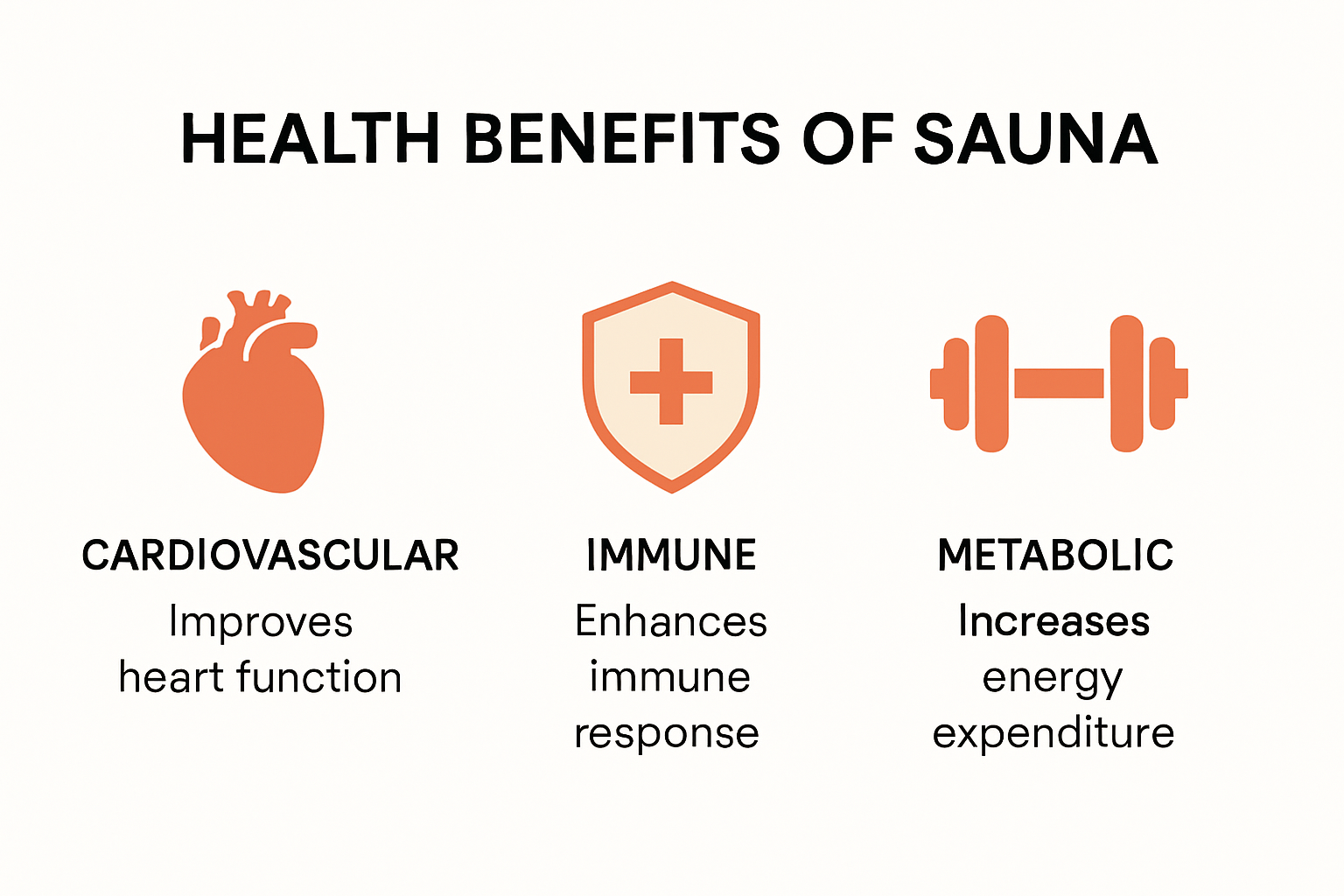
Top Benefits of Sauna Rituals for Wellness in 2025

Sauna rituals are gaining traction among wellness seekers worldwide. And while many people think a sauna is just a way to relax after a workout, the science shatters that assumption. A whopping 83.5 percent of regular sauna users report better sleep, and that’s only scratching the surface of the physical and mental benefits that go far beyond simple relaxation.
Table of Contents
- How Sauna Rituals Improve Physical Health
- Mental Wellness And Relaxation Benefits
- Choosing The Best Sauna Ritual For Your Home
Quick Summary
| Takeaway | Explanation |
|---|---|
| Cardiovascular and Circulatory Benefits | Regular sauna use enhances cardiovascular health by increasing heart rate and improving blood circulation, which may lower blood pressure and reduce vascular disease risks. |
| Immune System Boost | Sauna rituals stimulate the immune system by promoting white blood cell production and enhancing metabolic processes, contributing to better overall health and weight management. |
| Mental Wellness Enhancement | Sauna sessions improve mental health through stress reduction, emotional regulation, and better sleep quality, offering a natural method for emotional balance and psychological wellness. |
| Recovery for Athletes | Athletes benefit from sauna use for muscular recovery, as it reduces tension and promotes faster healing through improved blood flow and relaxation. |
| Personalized Sauna Experience | To maximize health benefits, individuals should carefully choose sauna types and practices that fit their personal wellness goals and living spaces. |
How Sauna Rituals Improve Physical Health
Sauna rituals represent a powerful wellness practice that goes far beyond simple relaxation. Physical health transformation occurs through a complex series of physiological responses triggered by controlled heat exposure. These remarkable benefits touch multiple systems within the human body, creating a holistic approach to wellness that modern health enthusiasts are increasingly embracing.

Cardiovascular Wellness and Circulation Enhancement
Sauna sessions trigger profound cardiovascular responses that mimic moderate exercise. Mayo Clinic Proceedings research demonstrates that regular sauna bathing significantly reduces risks associated with vascular diseases. When exposed to intense heat, the body experiences increased heart rate and improved blood circulation, similar to cardiovascular workout effects.
The heat causes blood vessels to dilate, promoting better blood flow and reducing peripheral resistance. This natural mechanism helps lower blood pressure and supports overall heart health. Harvard Health Publishing confirms that these cardiovascular benefits can contribute to long term heart wellness.
Immune System and Metabolic Performance
Sauna rituals stimulate the body’s natural defense mechanisms through controlled stress responses. The heat exposure creates a mild form of hormetic stress, which triggers cellular repair processes and boosts immune function. As body temperature rises, white blood cell production increases, potentially enhancing the body’s ability to fight infections and inflammatory conditions.
Metabolic processes also receive significant benefits during sauna sessions. The elevated temperature accelerates metabolic rate, potentially supporting weight management goals. Research suggests that a single sauna session can burn additional calories while promoting detoxification through increased sweating.
Muscular Recovery and Neurological Benefits
Athletes and fitness enthusiasts increasingly recognize sauna rituals as a powerful recovery tool. The heat helps relax muscle tissue, reducing tension and promoting faster recovery after intense physical activities. Increased blood flow delivers more oxygen and nutrients to muscle groups, supporting repair and reducing post exercise soreness.
Neurologically, sauna sessions may contribute to stress reduction and improved mental clarity. The controlled heat environment triggers the release of endorphins and helps regulate cortisol levels, potentially supporting better sleep patterns and overall neurological wellness.
By integrating sauna rituals into a comprehensive wellness routine, individuals can experience multifaceted physical health improvements that extend far beyond traditional exercise and relaxation methods.
To help readers quickly compare the different types of saunas discussed and their unique features, the following table summarizes Traditional vs. Infrared saunas as mentioned in the article:
| Sauna Type | Heating Method | Typical Temperature Range (°F) | Primary Benefits | Suitable For |
|---|---|---|---|---|
| Traditional Sauna | High-temperature air | 150 - 195 | Intense sweating, cardiovascular, relaxation | Classic sauna experience seekers |
| Infrared Sauna | Infrared light waves | Usually lower (below 150) | Gentle heating, targeted heat, potential for easier installation | People with space constraints or sensitive to high heat |
Mental Wellness and Relaxation Benefits

Sauna rituals emerge as a powerful sanctuary for mental restoration, offering far more than physical benefits. Psychological rejuvenation becomes an intricate dance of neurochemical responses and deep relaxation techniques that transform mental landscapes.
Stress Reduction and Emotional Regulation
Cleveland Clinic explains that sauna sessions trigger remarkable neurological responses, specifically the release of endorphins. These natural feel-good chemicals create a profound sense of relaxation and emotional balance. When individuals expose themselves to controlled heat environments, their bodies initiate a stress-reduction mechanism that helps counteract daily psychological pressures.
The physiological process involves lowering cortisol levels while simultaneously increasing serotonin production. This delicate hormonal recalibration helps individuals manage anxiety and emotional volatility more effectively. The controlled heat environment acts as a form of therapeutic intervention, providing a predictable and safe space for emotional reset.
Sleep Quality and Mental Restoration
Global Sauna Survey research revealed an astounding statistic: 83.5% of participants experienced improved sleep patterns after regular sauna use. Sleep represents a critical component of mental wellness, with profound implications for cognitive function, emotional stability, and overall psychological health.
During sauna sessions, body temperature rises and then gradually declines, mimicking natural circadian rhythm transitions. This temperature modulation signals the brain to prepare for rest, potentially reducing sleep onset latency and improving overall sleep architecture. Individuals struggling with insomnia or irregular sleep patterns might find sauna rituals a natural, non-pharmaceutical approach to sleep optimization.
Neurological Resilience and Mental Clarity
Mayo Clinic Proceedings highlights that sauna experiences produce physiological responses similar to moderate physical activity. These responses extend beyond cardiovascular benefits, significantly impacting neurological resilience. The controlled heat stress acts as a mild hormetic intervention, potentially enhancing brain plasticity and cognitive flexibility.
Regular sauna practitioners often report increased mental clarity, improved concentration, and a heightened sense of emotional equilibrium. The meditative aspect of remaining still in a heated environment encourages mindfulness, allowing individuals to disconnect from external stimuli and reconnect with their internal landscape.
By integrating sauna rituals into wellness routines, individuals create a holistic approach to mental health that transcends traditional stress management techniques. These sessions offer a multidimensional pathway to psychological renewal, combining physiological intervention with contemplative practice.
The table below organizes the main mental wellness benefits, paired with their scientific mechanisms as discussed in this section:
| Mental Wellness Benefit | Scientific Mechanism | Supporting Source/Statistic |
|---|---|---|
| Stress reduction | Endorphin release, lower cortisol levels | Cleveland Clinic |
| Emotional regulation | Increased serotonin, hormonal recalibration | Cleveland Clinic |
| Improved sleep quality | Body temperature modulation, circadian support | Global Sauna Survey (83.5% report better sleep) |
| Mental clarity & focus | Mindfulness, reduced external stimuli | Mayo Clinic Proceedings |
| Neurological resilience | Hormetic stress, enhanced brain plasticity | Mayo Clinic Proceedings |
Choosing the Best Sauna Ritual for Your Home
Selecting the ideal sauna ritual for your home requires careful consideration of personal wellness goals, available space, and individual health requirements. Home sauna experiences represent a personalized journey toward holistic well-being, with multiple options catering to different preferences and lifestyle needs.
Understanding Sauna Types and Personal Compatibility
Stanford University’s Lifestyle Medicine program emphasizes that the frequency and type of sauna use can significantly impact health outcomes. Traditional saunas, infrared saunas, and outdoor sauna installations each offer unique benefits that align with different wellness objectives.
Traditional saunas use high-temperature air to create intense heat, typically ranging between 150 to 195 degrees Fahrenheit. These environments provide a classic heat exposure experience that promotes sweating and cardiovascular responses. Infrared saunas, in contrast, use light waves to penetrate body tissues directly, offering a more gentle and potentially more targeted heating approach.
Space Considerations and Installation Strategies
Vail Health recommends evaluating home spaces critically before sauna installation. Factors such as available square footage, electrical requirements, and ventilation play crucial roles in determining the most suitable sauna configuration.
Individuals with limited indoor space might consider compact infrared units or portable options that can be easily integrated into bedrooms, bathrooms, or dedicated wellness areas. Outdoor enthusiasts might prefer standalone sauna structures that can be placed in backyards or garden spaces, creating a natural wellness retreat.
Health Optimization and Ritual Design
Mayo Clinic Proceedings research highlights the importance of developing a consistent sauna ritual that aligns with individual health goals. Frequency, duration, and temperature become critical variables in maximizing potential wellness benefits.
Beginners should start with shorter sessions lasting 10-15 minutes, gradually increasing duration as body tolerance improves. Hydration plays a critical role in safe sauna practice, with experts recommending water intake before, during, and after sessions. Additionally, individuals with pre-existing health conditions should consult healthcare professionals to ensure sauna use remains safe and beneficial.
Creating a personalized sauna ritual involves more than selecting equipment. It requires developing a holistic approach that integrates temperature exposure, mindfulness practices, and consistent engagement. By thoughtfully designing a home sauna experience, individuals can transform a simple heat exposure into a comprehensive wellness intervention that supports physical and mental health.
Frequently Asked Questions
What are the main benefits of sauna rituals for wellness?
Sauna rituals provide numerous benefits, including improved cardiovascular health, enhanced immune function, better muscular recovery, reduced stress, and improved sleep quality.
How do sauna sessions enhance sleep quality?
Regular sauna use can promote better sleep by modulating body temperature, which signals the brain to prepare for rest. Research shows that 83.5% of regular sauna users report improved sleep patterns.
What types of saunas are available and which one is best for me?
There are several types of saunas, including traditional and infrared saunas. Traditional saunas use high-temperature air, while infrared saunas utilize infrared light. The best type depends on personal preferences and health goals, such as space availability and heat tolerance.
How often should I use a sauna for optimal health benefits?
For beginners, sessions should start at 10-15 minutes a few times a week. As your body adapts, you can gradually increase the duration and frequency, but always consult with a healthcare professional, especially if you have existing health conditions.
Transform Your Wellness Rituals Into Lasting Results
Are you inspired by the proven benefits of regular sauna rituals but find it challenging to bring this powerful wellness practice into your own home? Many readers face the same struggle—yearning for better sleep, stress relief, and improved circulation, but not sure where to start or which type of sauna experience is right for their space and lifestyle. The article highlighted the importance of personal compatibility, optimal heat exposure, and creating a dedicated wellness zone to unlock the true rewards of a home sauna ritual.
Discover how Best Life Sauna can turn your wellness goals into reality with premium sauna solutions designed for real life. Choose from traditional or advanced infrared saunas, explore accessories that elevate your ritual, or consider a cold plunge tub for total body revitalization. Every product is backed by a price match guarantee and outstanding customer support, so you never have to compromise on quality or peace of mind.

Ready to take control of your health today? Visit Best Life Sauna to browse exclusive offers, shop the latest sauna innovations, and step confidently into your most energized year yet. Start your journey to deeper relaxation and sustainable wellness now with trusted solutions that fit your goals and your home.

